(This is a guest post from Antoni Sawicki aka Tenox)
I’ve been hunting for a complete set of INTERACTIVE UNIX System for quite some time. While I had the “basic set” of it, the real stuff Visix Looking Glass graphical environment was nowhere to be found. Recently I got my hands on a box containing a massive set of 5.25″ floppy disks. Without further delay this is how the famous 386 UNIX GUI looks like: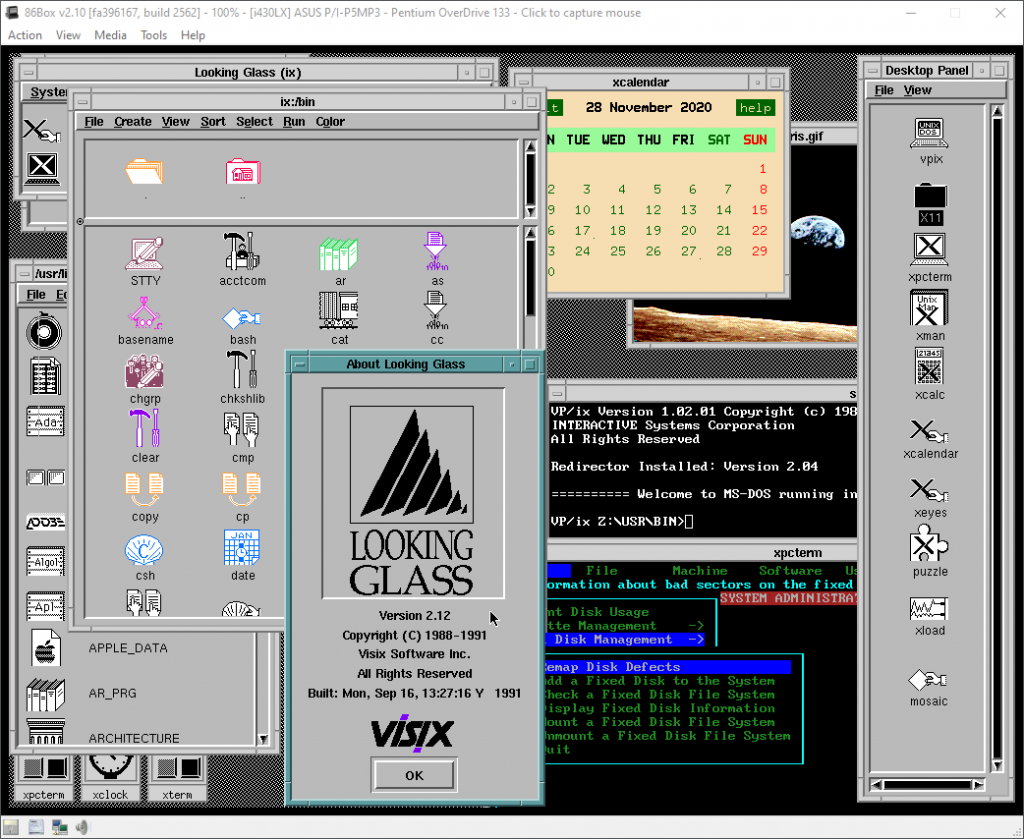
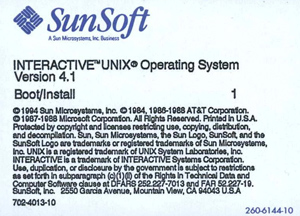
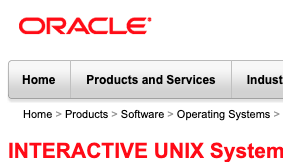
Fortunately thanks to 86Box you can enjoy a fully working OS in a “high-res” (1024×768) mode, 256 colors and working TCP/IP. You can even pretend to browse the web using early version of Mosaic and WRP:
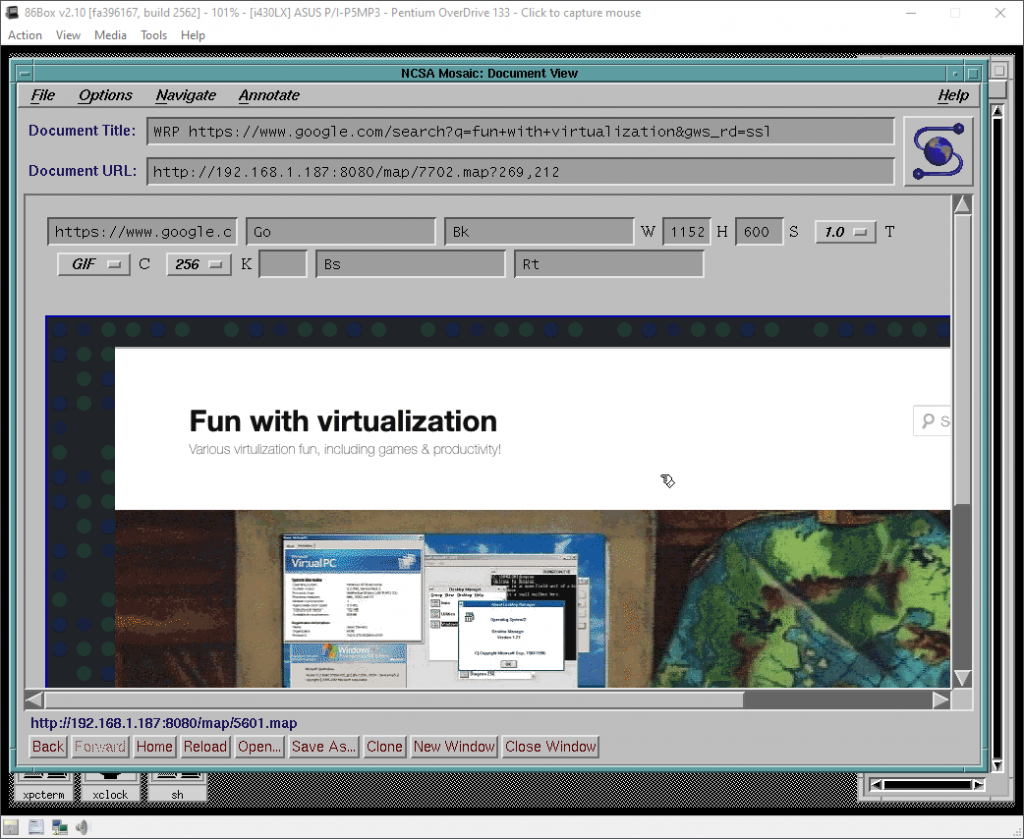
Looking Glass comes with a file manager and funky icons for pretty much every utility in the system:
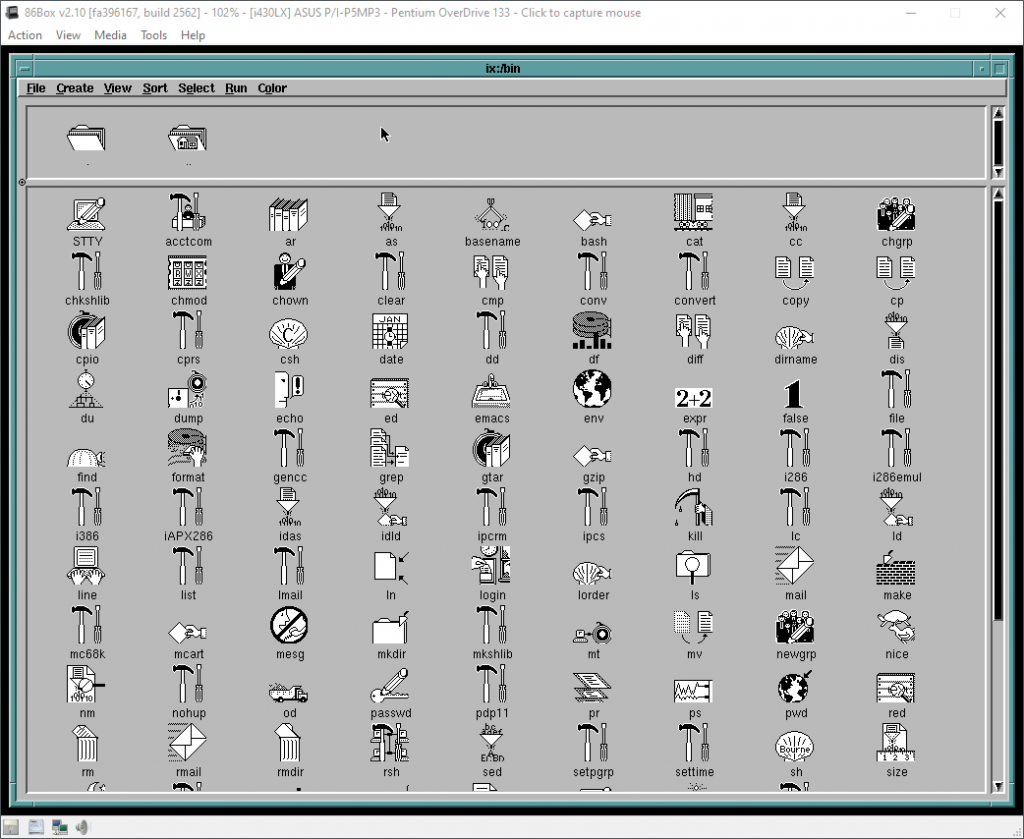
The OS has a bunch of GNU apps and I even found a super early version of xv:
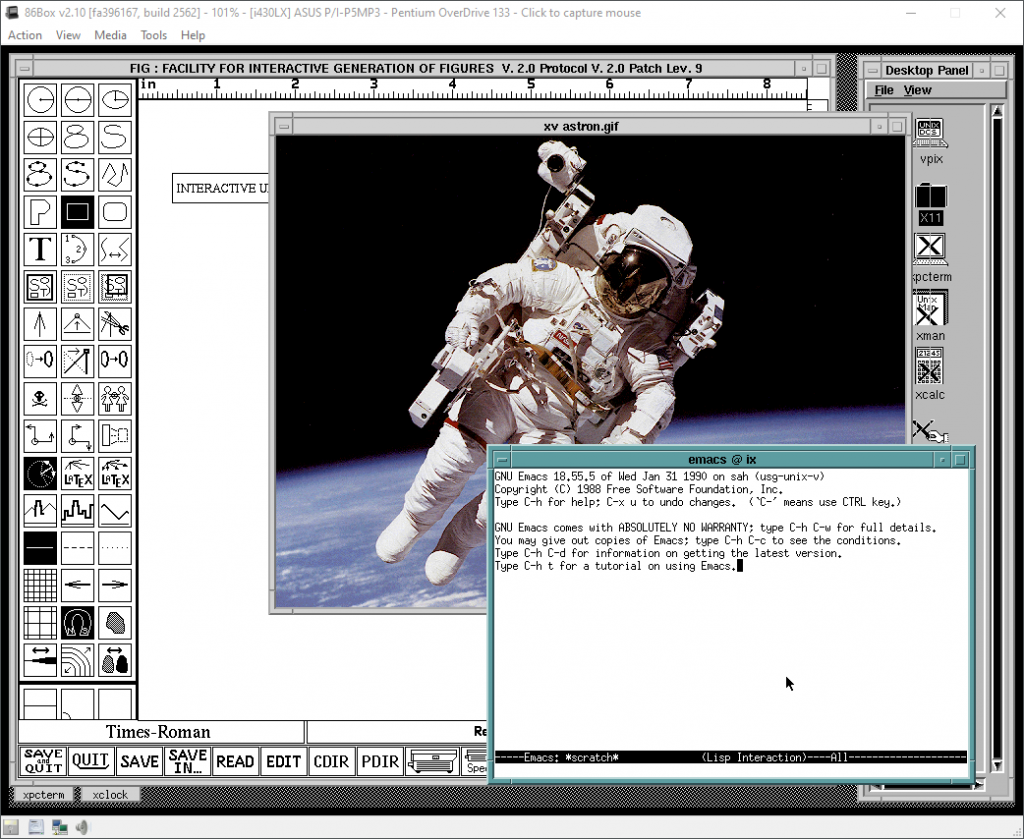
Finally this is how you manage the system with a “sysadm” utility and “kconfig” kernel configurator:
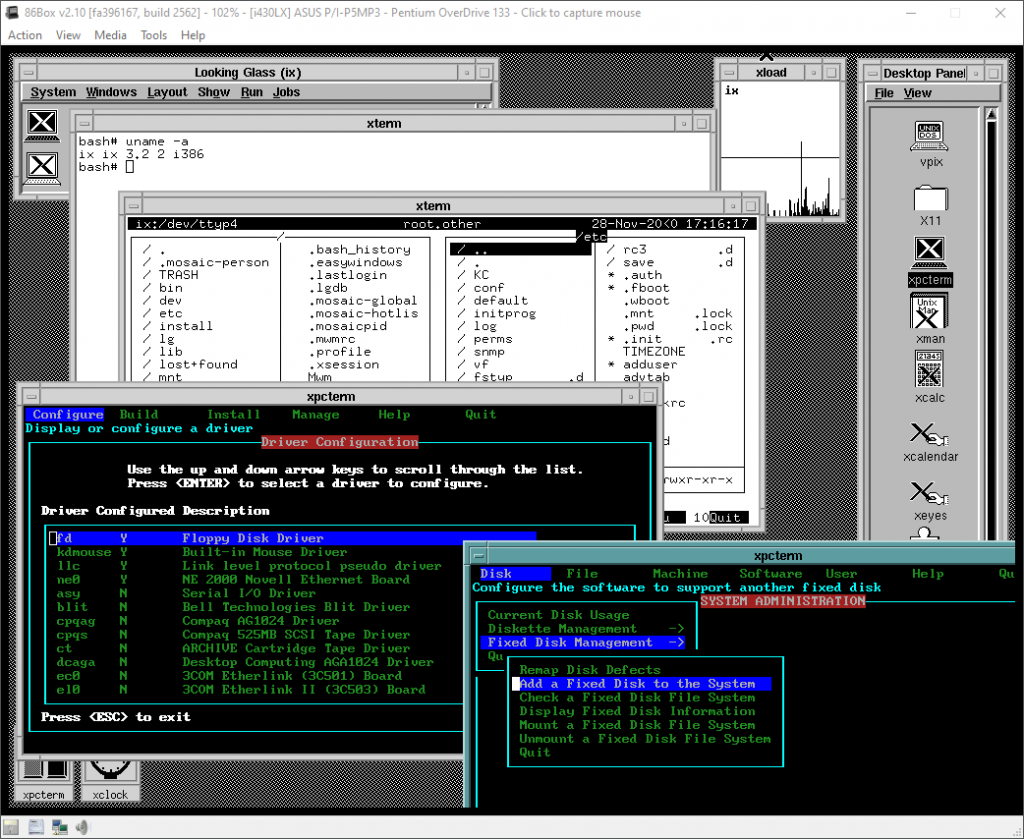
On a text console side, the OS has virtual consoles switchable via SYSRQ + F key. Console is on F8.
One should probably appreciate that PC had such a cool Unix version before Linux was even born. Unfortunately this stuff was all prohibitively expensive and mortals could not afford it to run on their 386s.
You can download 86Box version here. Make sure to look at readme for some last minute updates. Especially around configuring TCP/IP and Looking Glass licensing. There also is a VirtualBox OVA, however it only works in 800×600 and no networking/tcpip. Additional software can be downloaded from funet ftp. Install disks are here.
Also you may be interested in a follow up article covering VP/ix DOS hypervisor included with the OS.
Have Fun With Virtualization!

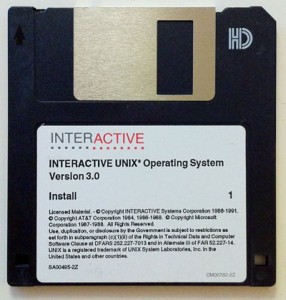
Thank you for sharing this!
Is there a way to get this running using Qemu[Q for OS X]. I've compiled Bochs under OS X but I can't because of a "bus Error" in Bochs under OS X.
PS Sorry for my bad English
hi,
i'm trying to boot this on a thinkpad t42 (not in an emulator) from grub (chainloder –force +1) and all i can get is an error message that says 'PCI parity error on bus/device/function 00F0h".
now i'm not expecting you solving my problems, just tell me if you've tried it and it's not impossible. it'd be really cool to load this ancient SysV version from grub. oh, and don't ask why, i'm just a sucker for these things. :))
thanks,
bamdad
oh, by the way, i've compiled bochs on linux with cirrus support, but there's a strange and rather annoying bug which is exclusive to the linux version: anytime i press shift, it messes up the terminal and from then on everything is upper case. even mouseclicks don't work in X. it's like if the shift key is 'stuck'. did you have this problem?
anyway, thanks for sharing this, i'll try to get around the bugs and see if i can get networking running.
Sorry, I kind of gave up on linux as a desktop somewhere around 1996 – 1997…
It stemmed from the modules, eth0, and X11… Things I just can't stand…. Oh and all the libc's!
hey, thanks for responding. i know what you mean, linux sucked royally before 2003-4. i'm not a linux advocate or anything, but if you're willing to try again, nowadays is probably a good time.
anyway, i've fixed the issue, so to anyone having weird keyboard problems: turn off any keyboard mapping customisations and switch the layout to us. then it'll work fine.
getting networking is really a pain, especially in bochs. i'm trying to get it working under qemu, i'll report back here.
If anybody else is searching, I have a complete set of disks and manuals for Interactive Unix stashed away in a closet.
@Deathgrip: which version? are they still working? are you willing to dd+scan them? or maybe sell the whole set?
@neozeed: could you please reupload this? i’ve fscked up the boot image beyond fsck (pun intended) and don’t have the original zip.
I’d second bamdad. Can you please reupload this? I missed the time to download this one.
Please, please, pretty please! With cherry on top!
Cheers,
joe
check it now.. must have gotten misplaced in the great shuffle.
Thanks a lot!
Is there any chance that you could upload the installation media as well?
yeah, i’d like that too.
Unfortunately, I am not in possession of those, Tenox is.
Thanks for sharing this. I used Interactive UNIX in the early 1990s when dozens of us in my area set up a UUCP calling tree to exchange mail and Netnews with the rest of the world. We had a mix of Amigas, AT&T UNIX PCs (7300/3B1), and Intel boxes (mostly i386s, though I think the rich guys had i486s) running Interactive, all calling each other hourly.
I picked up my copy of Interactive at Weird Stuff Warehouse in the Bay Area. All the white boxes filled my shopping cart. Shortly thereafter, Linux grew up enough to use and I switched to that and have been running it ever since. Still, it’s good to see Interactive preserved and not forgotten. It has a place in the history of UNIX on desktop hardware.
I’m lurking around Weird Stuff every so often. Too bad the most interesting stuff is behind the Staff Only sign…
BTW what version of Interactive Unix did you pick there? I’m looking for 4.1 Workstation which included the Looking Glass environment.
I wonder if you can make 4.1 available for testing. 😉
Any word about the installation media? Interactive Unix is getting rarer and rarer!
im like a kid with candy !
this is great !
I should probably find a ‘random’ button so you can jump to random pages.. Hopefully I’ve got tonnes of stuff on here by now…!
No reply? At least you can borrow the installation media from Tenox, image it to the website and give it back to him.
I was hoping he’d reply I don’t have access to any of the install stuff… or ask him, he isn’t that hard to find.
At least, not all hope is lost. For those who wants to keep Interactive Unix, I found an older version, 2.2, surfacing on ftp://themacarchive.net/bsd%20-%20other%20*nix/AT&T%20unix%20-%20sys%20v/
User: guest Pass: guest
This is the only version of interactive unix with looking glass desktop in installation media form. If you want to have a look, you are certainly welcome to do so. However, there are some drawbacks as I tried to get it to work; be aware that you need to download all of the archives “AT&T Unix 2.2 [3.2].rar, AT&T Unix 2.2 [3.2].r00 and AT&T Unix 2.2 [3.2].r01” You need teledisk to write them onto floppies, or you can put it in a dos vm, and convert from there because teledisk is a dos program. Installing X11 with looking glass worked ok. However, starting them failed. This is as far as I got:
cd /usr/bin/X11
./startx
startx: xinit: not found.
Executing ./X gets me a blank screen
Executing ./xdm acts like hiccups: it changes resolutions and then gets me back to the command line.
Maybe you could help me out with the issue? If you want the image installed in bochs, please tell me so I can upload it.
hi can anyone help me with installing interactive on an ide disk. my problem is that after booting theres always message “LIL-”
somehow bootloader doesnt work – but some years ago this worked
maybe theres someone with experience.
Sounds like reminiscence of LILO in the MBR. Try to boot with MS-DOS bootable disk and run fdisk /mbr.
that i have already done, but then there appears the dos message that theres no operating system present. is there a possibility to copy mbr from another disk to the new , because i have an existing disc which boots to interactive,but stops then with fsck – without possibility to cancel fsck.
if you are interested – i copied mbr from old disc and put it on new disk. system now working – its still a productive system.
I’ve got a set of 30 original floppy disks (3.5”) with version 4.1. I tried several times over the last couple of years to get it running in a VM (VMWare or VirtualBox), but always failed. Has anybody succeeded in doing this?
try qemu, it has a lot more options when it comes to legacy emulation. maybe even bochs, if it can run aix, it should be able to run ineractive unix as well.
btw, is there any chance you can be convinced to make the images available somewhere? pretty please? : ))
i have disk images
I don’t think I ever got it up on VMware. VirtualBox may be easier. I would suggest to contact Michal Necasek of os2museum. He has a high success rate of patching things to run in Vbox.
How to convert teledisk to somethign readable by virtualbox or qemu?
Thanks
See this: http://www.os2museum.com/wp/?p=1926
please,how to install on qemu?
I fail on disk partitions
i use classic
qemu -fda -hda
BINGO!
I have found a method to avoid ide bug,is simple..using scsi controller!
On virtualbox use scsi controller buslogic,and use drivers floppy
http://linux123.no-ip.biz/foto/InteractiveUnix.png
🙁
Won’t boot,only install
solution found,
Here’s a fast guide
1)Use Virtualbox
2)Create a old machine(freebsd 32bit),controller scsi buslogic,disk 900mb,and floppy controller
3)Insert boot floppy image,boot,insert serial and when ask insert loadable drivers and load driver scsi 6,buslogic
4)select on menu
format=no
partition=yes
analysis surface=no
5)install system
6)Important before reboot install kernel config diskettes
(again) loadable drivers,select buslogic
and reconfigure kernel with kconfig from menu(select configure/hpdd/reconfigure hpdd),install kernel
7)Reboot
http://linux123.no-ip.biz/foto/InteractiveUNix3.png
I tried to install interactive unix in virtualbox from the 4.1.1 media that I still have in a long forgotten box.
I imaged the floppies to disk and used them from there. Unfortunately I do not have the looking glass version either. Just the basic with networking included.
I could install interactive using the buslogic drivers, but then after the installation is complete and I reboot I get a message “Missing operating system”.
Does anybody know from where this error message comes ?
When I then attempt to install again the interactive unix installer will the the previously installed disk in the virtual machine and offer to do an update. So I think the installation worked successfully and it is just a matter of getting it to boot.
If I had to bet, your hard disk may be too big.
I tried images of size 2048mb and 1024mb with the buslogic and the aha-154x drivers.
Better with 512mb sized images ?
I looked at the manuals provided here:
http://tenox.net/docs/
There is nothing specifying a size limit, it even talks about disks larger than 1024mb in these manuals.
But I’ll try that suggestion. Ty
I’d try something under 500MB.. Plenty of older stuff typically have limits around the drives of the era, and were pretty silent about it, and nobody noticed as getting a 1GB or 2GB disk was something that would have been either far too big, or expensive if it even existed.
Or that’s been my experience with PC UNIX, the filesystem may technically go to 2GB with FFS/UFS but the older filesystems were maxed in far smaller spaces. Xenix being particularly picky about needing to live in under 500MB for the boot loader to install correctly as well.
You may have to use MS-DOS 5 to put a MBR on the disk as well. I vaguely recall not everything would put one on the disk if it were zeroized.
So I tried with various sizes:
512MB disk: worked, I was able to install and boot ius 4.1.1
1023MB disk: It installed, but I was not able to boot from the disk image
1024MB disk: same as 1023MB disk
2048MB disk: same as 1023MB and 1024MB disk
However I can mount partitions from the bigger disks as a second drive when I boot from the 512MB disk.
The partitioning program on 4.1.1 offers to fix the mbr. I did not need to copy a MSDOS mbr.
raganata reported on November 22, 2014 at 8:32 am in this instructions above that he used a 900mb disk. I wonder if not the disk size is the problem, but the partition size of the root partition.
I am still looking for installation media of 4.1.1 ius with the graphical environment since I only have the network edition of it.
And I am willing to share my floppy disk images of the network edition of ius 4.1.1 if anybody is interested.
Networking also works fine
Using pcm lance (the first and oldest nic
on virtualbox)
http://linux123.no-ip.biz/foto/interactivetcp.jpeg
scammer picture link? malicious ragazzakatana?
ERR_ADDRESS_UNREACHABLE
Just the inevitable death of content.
It was used by the US Army as the base operating system for the Standard Army Retail Supply System-1 (SARSS-1) back in 1992. It was available as part of the Small Multipurpose Computer contract.
Use mkpart to write the boot sector. I have several disks with ISC 4.1.1 and maybe the installation media as well if you still need it.
I ran across this post because I loved dfs because it reported df in human readable text instead of blocks. The largest disk we every used was probably a Seagate 4.2GB Ultra SCSI 320 on DPT and Adaptec controllers. Unfortunately I still have these as well 🙂
Hello coggins,
if you still got installation media or an installed version of 4.1.1 with the graphical environment that would be swell.
I have submitted a version of 4.1.1 with networking, but without graphical environment to vetusware and it is also on winworldpc now.
The networking version of IUS 4.1.1 works in virtualbox with the adaptec scsi disk driver and the amd lance net device.
BR
Nice article! I wrote it several times and tested the bochs image. Works fine.
Anyone: sources for install media containing the X11 Window System for INTERACTIVE consisting of the following floppy disk sets?
– System and Servers (3 disks)
– Display Servers (2 disks)
– Clients (3 disks)
I found one listing but there seems to be no download option :-\
http://www.typewritten.org/Software/#Sun
I want to try it with real ‘386 hardware which already running INTERACTIVE 386/UNIX r3.2, v4.1
Cheers
Did you ever get a working system up and running with Looking Glass? I have an old program I need to run under Interactive Unix and am hoping to find either a virtual machine that I can download or perhaps a disk image that I could use?
I have updated the article. Check it out 🙂
Before not but with “new fiiles” on tenox’s ru-mirror it should be possible, see update on this article from tenox above. My setup is on real hardware, just because it supports a Weitek 3167 and comes with LPI’s New C compiler and libs to support the special mem-mapped FPU for x86. That’s “gaming”, at least for me. By now I don’t know how but maybe get some idea to do simple stuff. 😀
Pingback: Emulation and virtualization guides – Vesko's Blog
http://tenox.pdp-11.ru/interactiveunix/interactive_unix_bochs.rar has a pre-installed interactive unix, it also works in 86box and should work in any other emulator/hypervisor. I’m going to post another image and maybe few more screenshots too / update the article.
Thanks. I downloaded the bochs image and it runs fine on a Windows XP machine. I need access to a physical parallel port because my old program uses a parallel port dongle. Is this possible with the bochs image? If not, I guess my only alternative is to track down install disks or images and install to an old 486 machine I still have. Unfortunately I seem to have discarded my original install disks for Interactive Unix.
Yes it is possible, what emulator or hypervisor do you use?
VMware Workstation supports parallel ports, so that would be my preference.
You should be able to run that image on vmware no problem.
I’m running the free version of VMware Workstation Player 16. How do I import the hd.img to Player?
Qemu disk tool to convert?
I created a blank VM in Player and then used a Linux bootable CD (Knoppix 7.2) to boot up the VM. Next I used ‘dd’ to copy the file hd.img to the blank vmdk disk:
dd if=/media/sdb1/hd.img of=/dev/sda
This successfully copied files to the .vmdk disk.
Then I restarted my new Player VM with the Knoppix CD removed. It began booting Interactive Unix but stopped with an error “PANIC: srmount – cannot mount root”.
Any ideas how to fix this?
It’s probably because mount is looking for a specific hard disk id/path to mount it and you may have it attached as a different hdd. I would just convert the disk format using some tool rather than dd it from another vm.
I have just updated the article and disk images. It now includes proper OVA file for VirtualBox and VMware. Version 3.0 has Looking Glass GUI. 4.1 is text mode but it has networking.
Just wanted to say thank you to tenox. I have been searching around the net for an interactive unix setup (floppies, VM settings, etc) and found this site a couple of days ago. Some friends and I used to run a multiuser BBS on IU3.2 back in the 1990s, and, feeling nostalgic, wanted to recreate it from an old backup tar. But we couldn’t get the files to boot, and our copies of the floppies are corrupt. The OVA vm’s you just uploaded should give us a good start. I did download the floppies from your site, but I couldn’t get it to actually partition the hard drive. It got to that point and froze. So hopefully I can use your OVA in virtualbox as a starting point to get our files restored.
Glad this is of use. I think the key to partitioning a drive is to keep it below LBA size, so essentially just below 500 MB. The 3.0 has no networking but it has working GUI. 4.1a has working network but no GUI.
Thanks. My biggest problem is I can’t seem to get a cdrom drive to work with the vbox VM (3.2 or 4.1 versions)
Our backup in on a tar file that is 470mb in size and I can’t seem to find any way to get the system to see the file. I was hoping to get the CD-ROM working and put the tar file on an iso9660 disc. Any tips?
There are many ways but why won’t you try to transfer it over network? FTP or NFS?
I also want to say thank-you. I really appreciate your help.
Check out latest update to the article. Now I have fully working X11 and TCP/IP 🙂
I was doing some deep cleaning in the office and found my full set of 3.5″ install disks for Version 4.1. Total of 35 disks. I managed to image them all, but can’t install because I must have thrown out the serial and authorization code card when I disposed of the manuals. If the images would be of use to anyone, I am willing to share.
Please do! Those disks are hard to find. Post a link if you can.
Here’s a link:
https://www.dropbox.com/s/j6fgmr1i2leijik/InteractiveUnixV4.1_InstallDisks.7z?dl=0
Excellent find, Gord! Thank you for sharing with us.
Now also X11 install media in version greater than 2.0.0 has been made available to a wider range of hobbyists to play with this vintage windows environment on virtualized hardware, or like myself, with real hardware. The bugfix release v2.0.2 should come i.a. with SVPMI files to support even better screen resolutions for some older graphics boards, like e.g. Matrox MWIN1280, if documentation is correct.
Also take a look into documentation, next to binaries. To my mind, both are a “must-play-with”. 🙂
At least with InstallDisk22_X11_v202_2of3.img I get errors on several operating systems (UnixWare 1.0PE, Slackware 14). Only me?
PMI-files are included (4400c.pmi, ati.pmi, xga.pmi) but no dedicated file for MWIN1280 (matrox.pmi) with X11 Server Xgp
What do you mean they are hard to find?
http://tenox.pdp-11.ru/interactiveunix/
Pingback: Fun with INTERACTIVE Unix 3.0 – Fun with virtualization - GistTree
Why can’t I access other websites? It says on 4.1a on VirtualBox:
ping: Unknown host http://www.google.com
you cant ping a URL…
Some (sad) updates.
This OS actually works fine on
VirtualBox: only one problem, I cannot connect it via virsh, if you try to compile gcc the system give a lot of errores and became really unstable, for the other is perfect, to install it use BusLogic
Vmware esxi 6: this hypervisor is one of the few with old buslogic controller simulated, so the system can work..only one problem, don’t recognize the floppy change, so is impossible to install it, I have also tried this trick: install on 86box and then import the image on esxi, but fail.
86Box: perfect emulation, but too slow
Qemu: a lot of problem even with the latest 8.1 version
configuration 1: ide controller = disk is not recognized
configuration 2: am53c974 controller = disk is recognized, fdisk return error about disk geometry
configuration 3: isa-ide controller = disk is recognized, after two seconds system hang
configuration 4: isa-pc controller = same thing as isa-ide
configuration 5: real pci ide controller passed trough pass trough = disk not recognized using old 1995 ide controller pci
configuration 6: real scsi buslogic controller pass trough = system hang during driver loading
I have also tried with coreboot bios (both i440 and q35) and I get same errors
I have also tried to using a disk image working with 86box (scsi controller enabled on kernel, ide support enable) but crash when try to mount root.
Actually (imho) qemu is (for Linux) the fastest “hypervisor”, better than VirtualBox (there is a new project with combine Virtualbox+kvm, if virsh can control vbox (officially is yes, but I try and I never get success) we can finally have this OS working, another solution would be buslogic support on qemu.
Thats’ all.
Latest qemu 9.0.2
I had installed Interactive Unix in a raw image using 86box
running qemu with this cli
#!/bin/bash
FLOPPY=boot_install.img
DISCO=disk.img
BOOT=c
RAM=16
qemu-system-i386 -boot $BOOT -m 16 -no-fd-bootchk –enable-kvm -device i8042 -device isa-vga -device ne2k_isa,netdev=network0 -netdev tap,id=network0,ifname=tap1,script=no,downscript=no -device isa-ide,id=isa0,bus=isa.0 -drive file=$DISCO,format=raw,if=none,id=disk -device ide-hd,bus=isa0.0,drive=disk -machine isapc
result
https://i.imgur.com/rEKqBFT.jpeg
As you can see, the disk is recognized but the boot
stuck-freeze, using scsi or ide-pci configuration lead to a
crash, as you can see
https://i.imgur.com/DRW92tV.jpeg
I’d probably try adding geometry to the hard disk.
Sadly new qemu doesn’t mean it’ll run anything. Compatibility was never their goal, like when they broke netware, they didn’t care.
Hi, I have tried to add cyls=,secs=,heads options but..nothing.
I have only success changing bios and using the -hda option, I can reach without problems the “mkfs” page, but the process crash when make the fs 😐
The bios used is the jetway_awd_600pgn_i815.BIN the line used is a simple
qemu-system-i386 -cpu 486 -bios jetway_awd_600pgn_i815.BIN -M pc -fda boot_install.img
https://images2.imgbox.com/ba/9e/AbsfBTnv_o.jpg
imho the only solution is qemu make buslogic driver, is the only driver working
on VirtualBOX, i have tried the am53c974 on qemu and 86BOX and both failed.
VMware has the buslogic driver/peripheral but give me error when try to change fd image to load buslogic driver.